“Should I put my extra ₱5,000 in a savings account, or is it better to invest it?”
If you’ve ever asked yourself this question, you’re not alone. Many Filipinos—especially young professionals—often get confused about whether it’s smarter to save or invest first. On the surface, saving and investing both mean setting aside money. But in reality, they serve very different purposes in your financial journey.
Saving usually means keeping your money in a safe place, like a bank account, where it’s easy to access but grows slowly. Investing, on the other hand, is about putting your money into assets like stocks, mutual funds, or real estate, with the goal of growing it over time—though it comes with more risk.In this guide, we’ll break down the difference between saving vs investing, show you when to use each strategy, and share practical tips so you can strike the right balance. By the end, you’ll know exactly how to decide whether to save or invest first, depending on your goals, timeline, and risk comfort.
What Is Saving? (The Safe but Slow Option)
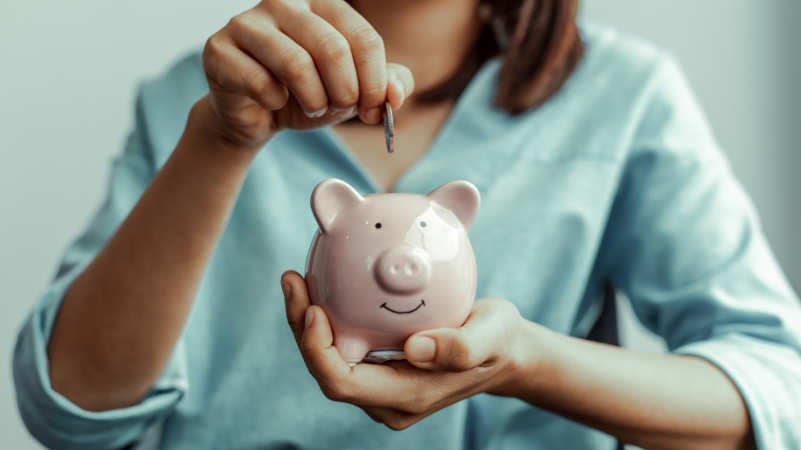
At its core, saving means setting aside money in a safe place where it’s easy to access when you need it. For most Filipinos, this usually means keeping money in a bank savings account, time deposit, or even e-wallets like GCash and Maya. Unlike investing, saving isn’t about growing wealth significantly—it’s about protecting your money and keeping it available for short-term needs.
When Do Filipinos Typically Save?
- Emergency fund – to cover medical bills, job loss, or urgent expenses.
- Tuition or education fees – many parents save gradually for their child’s next semester.
- House or car downpayment – short- to medium-term goals.
- Travel or lifestyle goals – whether it’s a barkada trip to Siargao or gadgets like a new iPhone.
Pros of Saving
- High liquidity – easy access anytime via ATMs, bank transfers, or e-wallet withdrawals.
- Safe and secure – deposits in banks are insured by the Philippine Deposit Insurance Corporation (PDIC) up to ₱500,000 per depositor.
- Stability – your principal (the money you put in) is generally protected.
Cons of Saving
- Low interest rates – most bank savings accounts in the Philippines offer only 0.25% to 2% per year.
- Inflation risk – with inflation averaging around 5%, your money loses purchasing power over time if it just sits in a savings account.
- Not designed for long-term growth – savings help with security, not wealth-building.
Example: The Inflation Effect
Let’s say you save ₱50,000 in a bank with a 0.25% interest rate. After a year, you’ll earn only ₱125 in interest. But if inflation is 5%, the actual purchasing power of your money decreases. That ₱50,000 might only buy what ₱47,500 could buy a year ago.
Saving is the safe but slow option—perfect for short-term goals and emergencies, but not enough if you want your money to grow faster than inflation.
What Is Investing? (The Riskier but Rewarding Path)
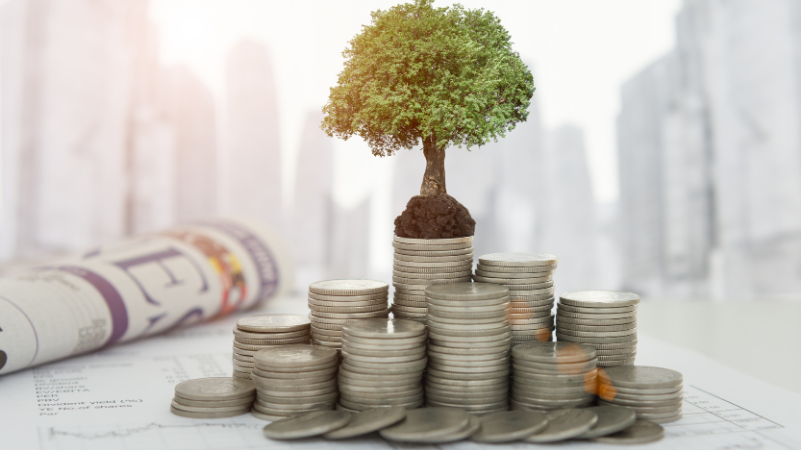
If saving is about protecting your money, investing is about making your money work harder for you. Instead of simply storing cash in a bank, you put it into assets that can grow in value or generate income over time.
For Filipinos, common investment options include:
- Stocks – buying shares of companies listed on the Philippine Stock Exchange.
- Mutual Funds & Unit Investment Trust Funds (UITFs) – pooled investments managed by professionals.
- Pag-IBIG MP2 – a government-backed savings program with higher returns than banks (historically around 6–8% per year).
- Real estate – buying property for rental income or long-term appreciation.
- Bonds – lending money to the government or corporations for fixed interest.
When Do Filipinos Typically Invest?
- Retirement planning – growing a nest egg for financial security in later years.
- Child’s education fund – investing long-term to beat rising tuition costs.
- Wealth building – growing assets to achieve financial freedom, buy property, or start a business in the future.
Pros of Investing
- Higher potential returns – historically much higher than bank savings.
- Compounding power – reinvested earnings generate more earnings over time.
- Goal alignment – matches long-term financial goals like retirement and wealth creation.
Cons of Investing
- Risk of loss – investments can go up or down, especially in the stock market.
- Requires patience and discipline – panic-selling during market drops can ruin gains.
- Longer time horizon – investing works best if you give your money years to grow.
Example: Saving vs. Investing in Pag-IBIG MP2
Let’s say you set aside ₱5,000 per month for 10 years.
- If you only saved in a bank at 0.25% interest, you’d have around ₱603,000 after 10 years (barely more than what you put in).
- If you invested in Pag-IBIG MP2 with an average return of 6.5%, you could grow that same money to around ₱820,000+ in 10 years.
That’s a difference of over ₱200,000, just by choosing to invest instead of only saving.
Investing is the riskier but rewarding path—ideal for retirement, education, and long-term wealth building.
Saving vs Investing: A Side-by-Side Comparison
Still unsure whether you should save or invest first? Here’s a quick comparison to help you see the differences more clearly:
| Factor | Saving | Investing |
| Time Horizon | Short-term (1–3 years) | Long-term (5+ years) |
| Liquidity | High – cash is easily accessible (ATMs, e-wallets, bank withdrawals) | Medium to low – funds may be “locked in” or take time to liquidate |
| Risk | Minimal – deposits are insured by PDIC up to ₱500,000 | Varies – can be low (Pag-IBIG MP2, bonds) or high (stocks, crypto) |
| Returns | Low (0.25%–2% per year) | Higher potential (4%–12% on average in the Philippines) |
| Ideal For | Emergency fund, tuition, travel, short-term goals | Retirement, child’s education, long-term wealth growth |
Quick Takeaway
- If you need cash security and flexibility, saving is your best bet.
- If your goal is beating inflation and building wealth, investing is the smarter move.
- For most Filipinos, the answer isn’t “saving or investing” but a balance of both—start with a strong savings foundation, then grow through investments.
When Should You Save?

So, should you save or invest first? The answer depends on your goals and timeline. Saving is the smarter choice in situations where security and quick access to cash are more important than growth.
Here are the best times to focus on saving:
1. When building an emergency fund
Every Filipino needs a safety net. Financial experts recommend saving 3–6 months’ worth of living expenses in a liquid account (like a bank savings account or e-wallet). This ensures you can cover rent, groceries, or bills if you lose your job or face a medical emergency.
2. When you need money in the next 1–3 years
If your goal is short-term, it’s better to save than to invest. Examples:
- Wedding fund – like saving for venue, catering, and other big-day expenses.
- Travel abroad – preparing for a Japan trip or Euro tour next year.
- Downpayment – on a house or car you plan to purchase soon.
3. When you’re risk-averse or just starting out
If the thought of losing money keeps you up at night, start with saving. It builds financial confidence and gives you a solid base before venturing into riskier investments.
Example:
Let’s say you want to get married in 2 years and estimate the costs at ₱500,000. Putting that money in a savings account or time deposit ensures it will be ready when you need it. If you invested it instead, market fluctuations could risk losing part of your wedding fund right before the big day.
Saving is best for short-term goals, emergencies, and financial beginners.
When Should You Invest?
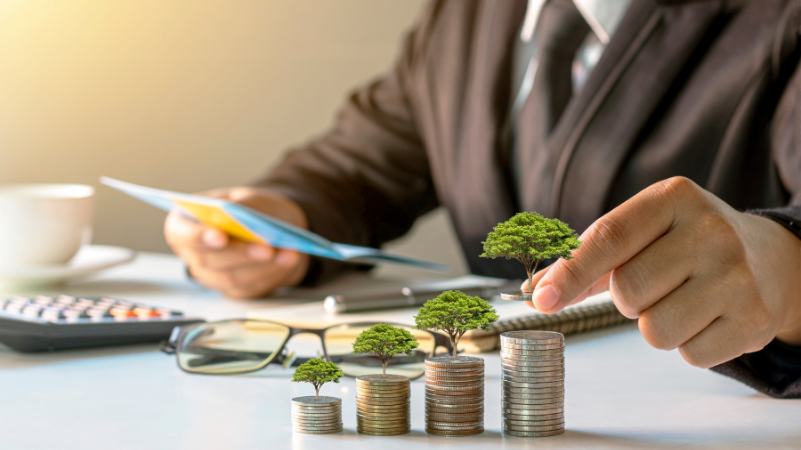
Once you’ve built your safety net through saving, it’s time to let your money work harder for you through investing. Unlike saving, which protects your money, investing helps it grow over the long term—a key step if you want to achieve financial freedom.
Here are the best times to consider investing:
1. If you already have an emergency fund
Before you invest, make sure you’ve set aside 3–6 months of expenses in a savings account. This ensures you won’t be forced to pull money out of your investments during an emergency (when the market may be down).
2. If your goal is 5–20 years away
Investing works best when you give it time. The longer your money stays invested, the more you benefit from compounding (earnings that generate more earnings).
3. If you’re preparing for big long-term goals
- Retirement – building wealth so you don’t rely solely on SSS or pensions.
- Child’s education – beating rising tuition fees by starting early.
- Property purchase – saving for a house or condo years down the line.
Mini-example: Starting Small with Local Investments
You don’t need millions to invest. Many Filipinos start with:
- UITFs or Mutual Funds – available from banks for as low as ₱1,000.
- Pag-IBIG MP2 – a government-backed program with historical returns of 6–8% per year.
- Stocks – you can open an online trading account and start with a few thousand pesos.
For example, if you invest ₱1,000 monthly in Pag-IBIG MP2 for 10 years at an average of 6.5% return, your money could grow to around ₱165,000+. Compare that to just ₱120,000 if you only saved—it’s a clear difference.
Bottom line: Investing is ideal once you’ve secured your emergency fund and are ready to grow money for retirement, education, or long-term wealth.
How Much Should You Save vs Invest?
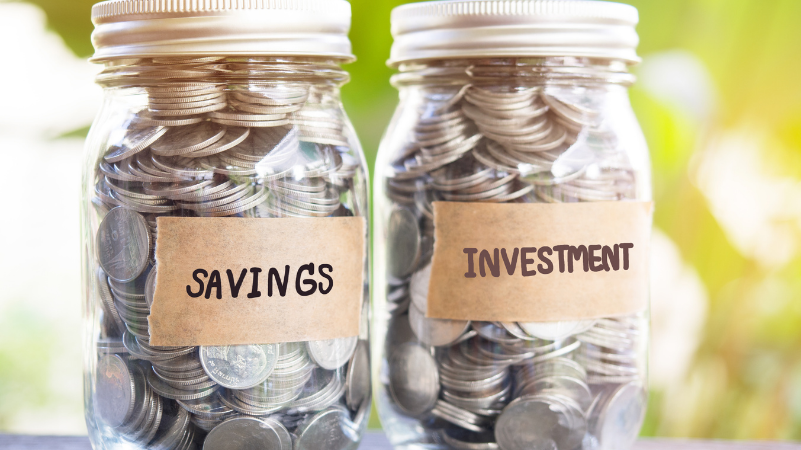
One of the biggest questions young Filipinos ask is: “How much of my income should I save or invest?” The truth is, there’s no one-size-fits-all formula—but there are simple budgeting rules you can use as a guide.
Popular Budgeting Frameworks
- 50/30/20 Rule (Global Standard):
- 50% → Needs (rent, food, bills)
- 30% → Wants (shopping, travel, leisure)
- 20% → Savings & investments
- 70/20/10 Filipino-Style Rule (More Practical for Local Context):
- 70% → Living expenses & debt payments
- 20% → Savings & investments
- 10% → Tithes, donations, or personal development
Both approaches highlight one thing: at least 20% of your income should go to savings and investments.
Step 1: Save First (Build Your Safety Net)
Before you think about investing, save enough to cover 3–6 months’ worth of expenses. This becomes your emergency fund.
Example: If your monthly expenses are ₱15,000, aim for ₱45,000–₱90,000 in a savings account or e-wallet.
Step 2: Invest Regularly
Once you have an emergency fund, start investing at least 20% of your income every month. You can split it across options like:
- Pag-IBIG MP2
- UITFs or mutual funds
- Stocks or ETFs
- Retirement funds (PERA account, long-term insurance with investments)
Calculator-Style Example
Let’s say you’re a young professional earning ₱25,000/month:
- ₱5,000 (20%) → Savings (until you hit your emergency fund goal)
- ₱3,000 (12%) → Investments (Pag-IBIG MP2, UITFs, or stocks)
- ₱17,000 (68%) → Expenses, debt payments, lifestyle
After 1 year, you’d have:
- ₱60,000 in savings
- ₱36,000+ in investments (plus growth from returns)
Over time, this habit builds both security (savings) and wealth (investments).
Key takeaway: Start by saving consistently, then shift more money toward investing once your emergency fund is secure.
Common Mistakes Filipinos Make
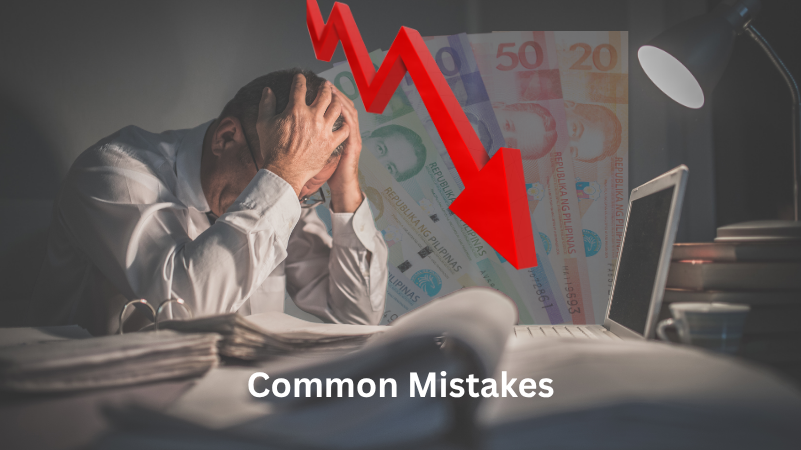
Even with the best intentions, many Filipinos fall into traps when it comes to saving vs investing. Here are some of the most common mistakes to watch out for—and how you can avoid them:
1. Only Saving, Never Investing
Many Pinoys keep all their money in savings accounts. While safe, this habit means your money is losing value to inflation (currently around 4–6% yearly in the Philippines). That’s why saving alone won’t grow your wealth.
Fix it: Once you’ve secured your emergency fund, start small with investments like Pag-IBIG MP2 or UITFs.
2. Investing Without an Emergency Fund
Jumping into investments without a safety net is risky. If a financial emergency hits, you might be forced to sell investments at a loss.
Fix it: Always save 3–6 months’ worth of expenses first before putting money into riskier assets.
3. Falling for Scams
Ponzi schemes and “double-your-money” offers are still common in the Philippines. If something sounds too good to be true, it usually is.
Fix it: Stick to legitimate, regulated investments—banks, Pag-IBIG, SSS, PERA, and SEC-registered products.
4. Not Diversifying
Putting all your money in one stock, one company, or even just one type of asset (like real estate) exposes you to unnecessary risk.
Fix it: Spread your money across different assets—stocks, funds, bonds, real estate, and even digital investments—to balance risk and return.
Final Thoughts: Finding the Balance
At the end of the day, the real question isn’t “saving vs investing”—it’s how to make them work together. Both play an important role in your financial journey:
- Saving gives you peace of mind and security for short-term goals (like emergencies, travel, or major purchases).
- Investing builds wealth for long-term goals (like retirement, buying a home, or funding your child’s education).
Think of it this way: savings are your safety net, investments are your growth engine. You need both to create a strong financial foundation.
Practical tip: Start simple. Build your emergency savings first, then begin investing gradually—even if it’s just ₱1,000 or ₱2,000 a month. What matters most is consistency, not the size of your starting amount.
Whether your goal is to save for short-term goals or to invest for retirement, remember: the earlier you start, the more time your money has to grow.
Don’t choose between saving or investing. Do both, step by step, and you’ll build financial stability today while securing your future tomorrow.




